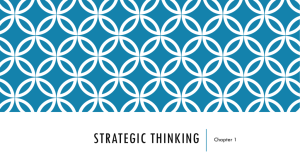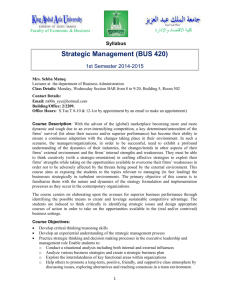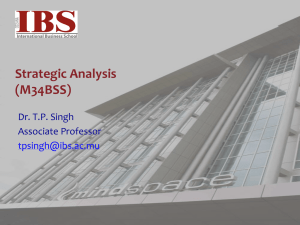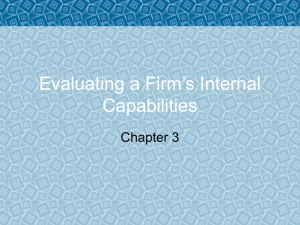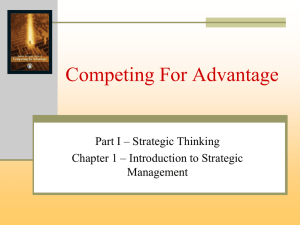The Strategic Management Process
advertisement
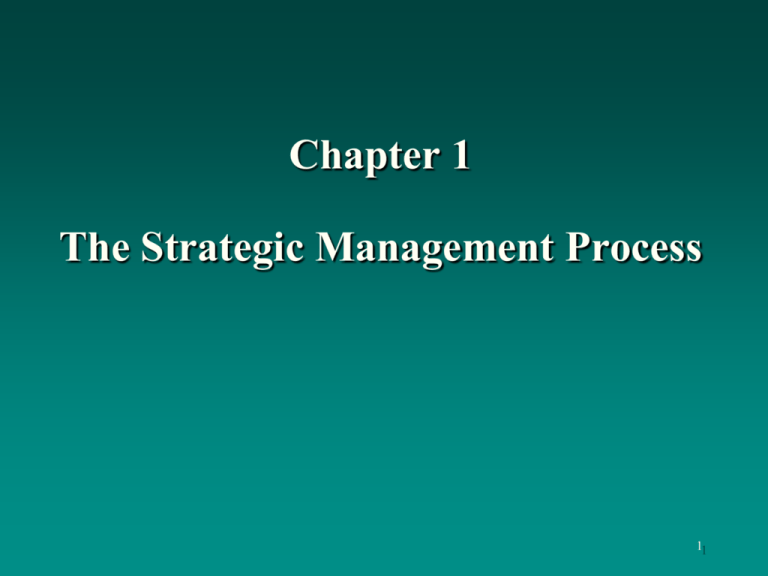
Chapter 1 The Strategic Management Process 1 Learning Objectives To understand: • the elements or stages of the strategic management process. • SWOT analysis. • the importance of strategic leadership and strategic direction. • the key elements of important strategic perspectives, including industrial organization economics, the resource-based perspective, and stakeholder theory. • how a turbulent and interdependent global environment has increased the importance of innovation in firms. • the elements of strategic thinking. 2 Strategic Management is the process through which organizations… analyze and learn from their internal and external environments, establish strategic direction, create strategies that are intended to help achieve established goals, and execute those strategies…. all in an effort to satisfy key organizational stakeholders. 3 Strategic Management Process External and Internal Analysis Strategic Direction Strategy Formulation (corporate and business level) Strategy Implementation and Control Strategic Restructuring 4 THE BROAD ENVIRONMENT sociocultural forces technological forces THE TASK ENVIRONMENT competitors suppliers THE ORGANIZATION owners/board of directors managers employees financial intermediaries customers unions local communities government economic forces activists political/legal forces 5 Broad Environment The broad environment consists of domestic and global forces such as: socio-cultural trends (e.g. demographics) technological trends (e.g. internet) political trends (e.g. open markets) economic trends (e.g. growing economy) The broad environment forms the context within which the firm and its task environment exist. 6 Task Environment The task environment consists of external stakeholders -- groups or individuals outside the organization that are significantly influenced by or have a major impact on the organization -- such as: Customers Suppliers Competitors Communities Financial intermediaries 7 Internal Environmental Analysis • Internal stakeholders include managers, employees and the owners and their representatives (e.g., board of directors). • Internal analysis includes an evaluation of internal stakeholders and the organization’s resources and capabilities • Purpose of internal analysis to determine strengths and opportunities for competitive advantage, and weaknesses and organizational vulnerabilities that should be corrected. 8 SWOT Analysis • Strengths are firm resources and capabilities that can lead to a competitive advantage. • Weaknesses are resources and capabilities that the firm does not possess but that are necessary, resulting in a competitive disadvantage. • Opportunities are conditions in the broad and task environments that allow a firm to take advantage of organizational strengths, overcome organizational weaknesses, and/or neutralize environmental threats. • Threats are conditions in the broad and task environments that may stand in the way of organizational competitiveness or the achievement of stakeholder satisfaction. 9 Strategic Leadership • Strategic leaders have a large impact on the strategies and performance of their firms High impact leaders like Sam Walton of Walmart, Jack Welch of General Electric or, more recently, Akio Toyoda of Toyota or Sam Palmisano of IBM. One of the most important responsibilities of a strategic leader is to establish strategic direction 10 Strategic Direction Strategic direction involves • setting long-term goals and objectives • defines the purposes for which an organization exists and operates business ethics pertain to the moral obligations of businesses to individuals, groups (such as stakeholders) and society as a whole values define what matters when making decisions and what is rewarded and reinforced Strategic direction may be contained, in part, in a firm's mission and vision statements 11 Strategy Formulation • Strategy is an organizational plan of action intended to accomplish goals. • Corporate strategy formulation refers to domain definition, or the choice of business areas. Usually decided by the CEO and the board of directors. • Business strategy formulation involves domain direction and navigation, or how to compete in a given area. Usually decided by division heads and business unit managers. • Functional strategy formulation contains the details of how the functional areas such as marketing, operations, finance, and research should work together to achieve the business-level strategy. Decisions made by functional level managers. 12 Strategy Implementation and Control • Strategy implementation involves creating the functional strategies, systems, structures, and processes needed by the organization in achieving strategic ends. • Strategic control refers to the processes that lead to adjustments in strategic direction, strategies, or the implementation plan when necessary. • Strategic restructuring involves a renewed emphasis on what an organization does well, combined with a variety of tactics to revitalize the organization and strengthen its competitive position. 13 Alternative Perspectives on Strategy Development Industrial Organization Economics • Environmental determinism – the most competitive strategy is determined by the environment. It involves adapting to environmental, technical and human forces • Structure-conduct-performance model – the performance of an industry is dependent on the conduct of the firms it contains, which is dependent on industry structure • Research – suggests industry is important to performance, but not primary determinant • Enactment – firms can, in part, create their environments. • Combination – organizations typically involved in adaptation 14 and enactment. Alternative Perspectives on Strategy Development Resource-based View • Organization is a bundle of resources – financial, physical, human, knowledge and learning, and general organizational (structure, systems, culture, reputation, relationships with stakeholders). • Sustainable competitive advantage – comes from a resource that is valuable in the market, possessed by only a small number of firms (rare), and costly or difficult to imitate in the short term. • Effective development or acquisition of organizational resources – may be the most important reason that some organizations are more successful than others. 15 Alternative Perspectives on Strategy Development Stakeholder Perspective • Organization is a network of relationships with stakeholders – internal and external constituencies that have a strong interest in the activities and outcomes of the firm and upon whom the organization relies to achieve its objectives. • Stakeholder analysis › › › › identifying and prioritizing key stakeholders assessing their needs collecting ideas from them integrating this knowledge into the strategic management process • Stakeholder management › › › › communicating with stakeholders negotiating and contracting with stakeholders managing relationships with them motivating them to behave in ways that are beneficial to the organization and its 16 other stakeholders Managing for Stakeholders and Value Creation Primary Stakeholders Sources of Competitive Advantage Excellent Reputation Potential for Value Creation More Attractive to Stakeholders Sales Growth Respectful Ability to Obtain Better Resources Efficiency Mutually Beneficial Ability to Obtain Valuable Information Fewer Negative Actions Greater Ability to Plan Less Risk Nature of Relationships Shareholders Employees Trusting Managers Customers Suppliers Communities Others Strategic Flexibility 17 A Combined Approach to Strategic Management • Traditional/contemporary perspective – firms should adapt to forces in the external environment when it is unreasonable to try to change them, while being proactive in other areas. Also, strategy making is a combination of planning and learning. The approach also draws from organizational economics, especially pertaining to industry analysis • Resource-based perspective – internal analysis leading to identification of sources of sustainable competitive advantage • Stakeholder perspective – part of external analysis and alliance formation • Global perspective – integrated throughout all aspects of strategic management 18 A Turbulent Global Environment The world's markets are becoming increasingly globalized • Increasing interdependencies – due to the flow of goods and services, knowledge and financial capital across borders. • Economic volatility – makes planning more difficult. • Interdependencies make business environment complicated. Economic interconnections even more problematic during crises. Global interconnectedness – has increased competition in many industries. Hypercompetition – intense competition among firms, often associated with technological innovation. These factors make continuous innovation important! 19 Entrepreneurship Entrepreneurship is the process through which individuals, groups or firms pursue opportunities to create new value Recognizing or creating an opportunity Assembling needed resources Managing resources to bring new venture into being 20 Strategic Thinking Strategic thinking is the term used to describe the creative aspects of strategic management Focus on strategic intent Long-term orientation Consideration of past and present Systems perspective Ability to seize unanticipated opportunities Scientific approach 21

